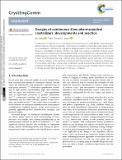Designs of continuous-flow pharmaceutical crystallizers: developments and practice
Author(s)
Jiang, Mo; Braatz, Richard D.
Downloadc8ce00042e.pdf (6.471Mb)
Terms of use
Metadata
Show full item recordAbstract
Crystallization is an effective, low-cost purification & formulation process widely applied to pharmaceuticals
and fine chemicals. This review describes recent advances in research on lab-scale solution-based continuous crystallization, including (1) a 5-step general design procedure; (2) key design/operational parameters;
(3) process intensification strategies; and (4) a case study. The continuous crystallizers reviewed include
mixed-suspension mixed-product removal, fluidized beds, oscillatory baffled flow, and tubular laminar/segmented/slug-flow crystallizers. Their corresponding design and operational considerations are summarized in terms of general parameters (e.g., residence time), and crystallizer-specific parameters and strategies (e.g., mixing strategies). In-line nucleation and crystal modification methods are categorized, including use
of micromixers, wet milling, ultrasonication, temperature cycling, and recycling selection (filtration, sedimentation). Throughout the article, links are drawn with extensive existing knowledge of batch crystallizers,
to facilitate the understanding and design of continuous crystallizers.
Date issued
2019-04-29Department
Massachusetts Institute of Technology. Department of Chemical EngineeringJournal
CrystEngComm
Publisher
Royal Society of Chemistry (RSC)
Citation
Jiang, Mo, and Richard D. Braatz. “Designs of Continuous-Flow Pharmaceutical Crystallizers: Developments and Practice.” CrystEngComm 21, no. 23 (2019): 3534–51. © 2019 The Royal Society of Chemistry
Version: Final published version
ISSN
1466-8033